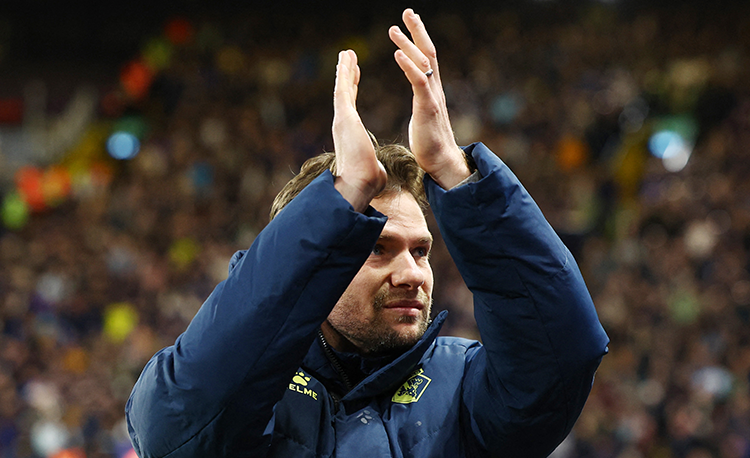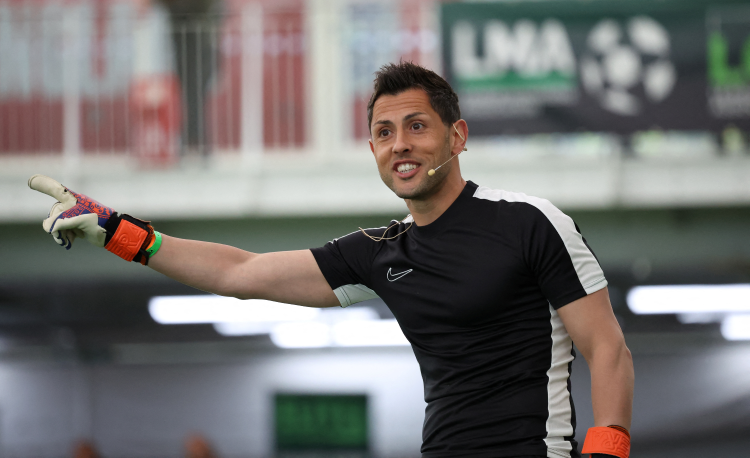You are viewing 1 of your 1 free articles
Crisis transition
This session deals with a crisis transition where a condensed space is broken, ie a press into a large space where players are required to transition to score or recover, focusing on attaining maximal velocity under time pressure.
| Area |
Half pitch |
| Equipment |
Mini goals, cones, full size goal |
| No. of Players | 7 + 1 GK |
| Session Time |
At coach’s discretion |
This session deals with a crisis transition where a condensed space is broken, ie a press into a large space where players are required to transition to score or recover, focusing on attaining maximal velocity under time pressure. This session is dynamic as it recreates a significant part of the game where crisis transitions occur on both sides of the ball. Ensuring a competitive element is key, where we break the group into defensive and offensive units to engage an outcome that is specific to them, along with creating a physical overload in terms of maximal velocity.
It’s designed to run in our speed-based session that would typically occur on MD-2. We ensure maximal output is balanced with maximal recovery, so that the drill doesn’t turn into a conditioning session. Quality is essential rather than quantity of reps; ensure each rep is at maximal intensity and velocity both physically and cognitively to manage the overload.
ACTIVITY 1
The two blue players on the halfway line accelerate 10m into the rondo box, where the reds are in possession in a 5v2 set-up [1a].
[1a]
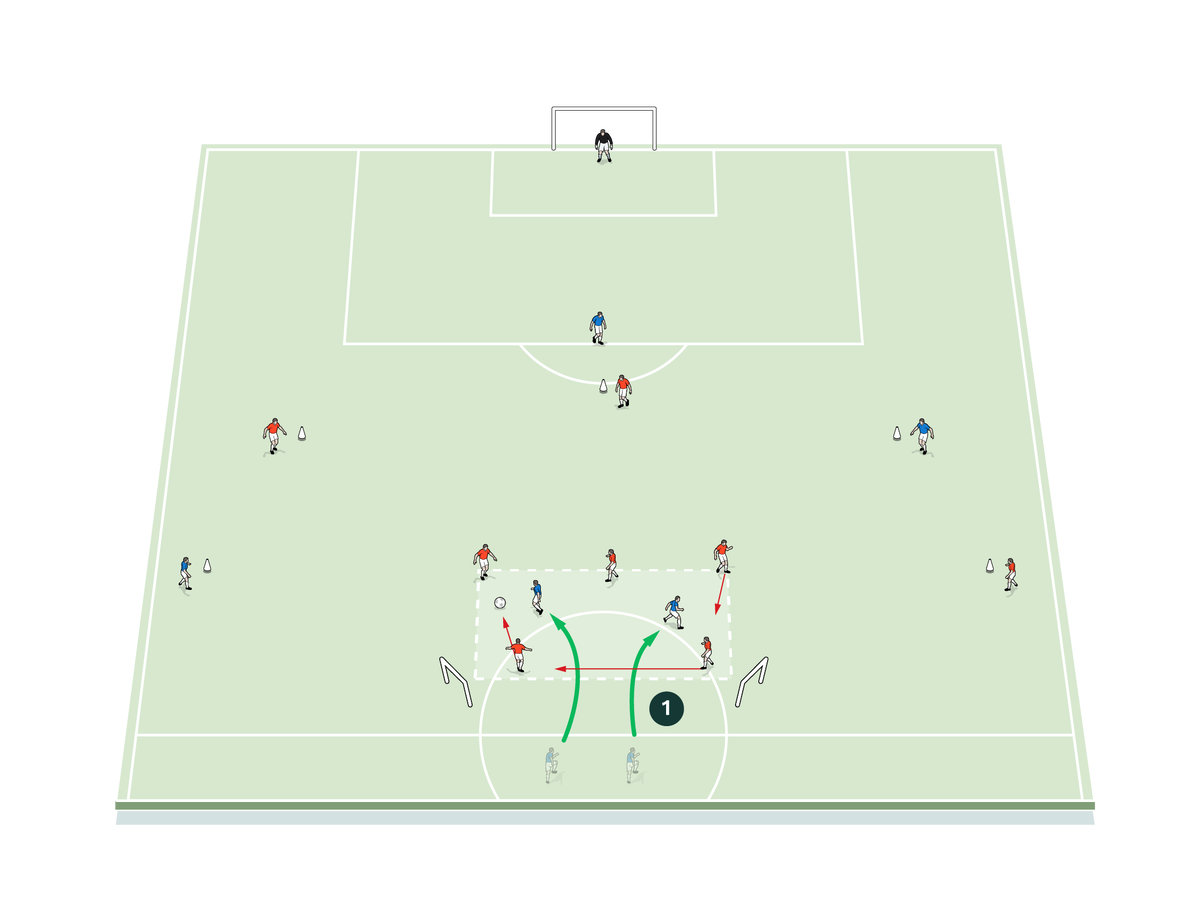
-
Two blue players on the halfway line accelerate 10m into rondo box, for 5v2 rondo against reds
If the blues win the ball, they can score in one of the mini goals [1b]. If the reds reach a certain number of passes (at the coach’s discretion) they can break out.
[1b]
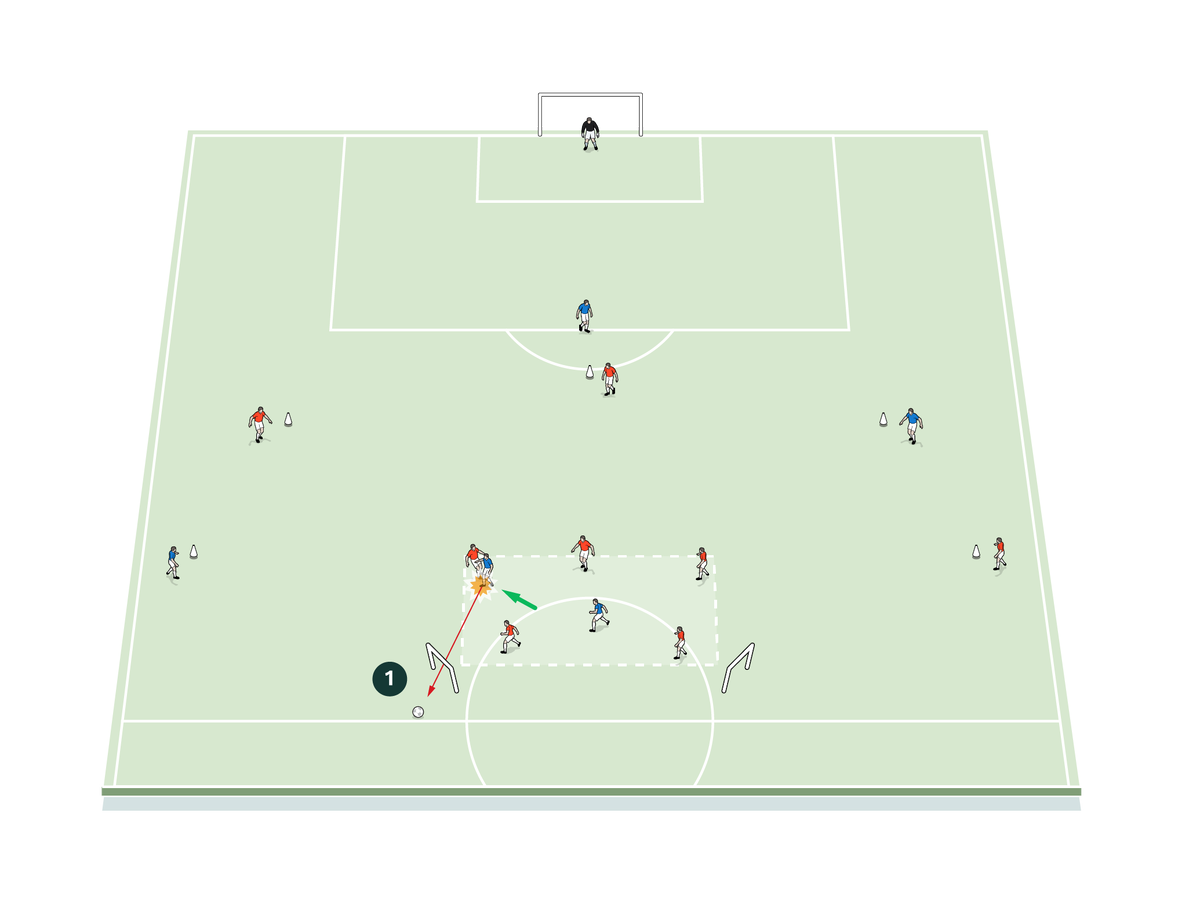
-
If the blues win the ball, they can score in mini goal
When the reds break out, they play it out to the forward, and two reds from the rondo box join the transition to goal along with the attacking and defending players set out on the yellow markers. It turns into a 5v2 transition to goal [1c]. All players are required to hit their top speed in order to recover or maintain their time edge.
[1c]

-
If the reds reach a certain number of passes they can break out, playing out to forward
-
Two reds from rondo box join transition to goal along with attacking and defending players set out on yellow markers, creating 5v2 transition to goal
ACTIVITY 2
We can progress this by setting up in a similar way, with the first part just the same as the first time, with the two blues accelerating into the rondo box, but this time if the blues win the ball and score in the mini goals, it is worth two [2a].
[2a]
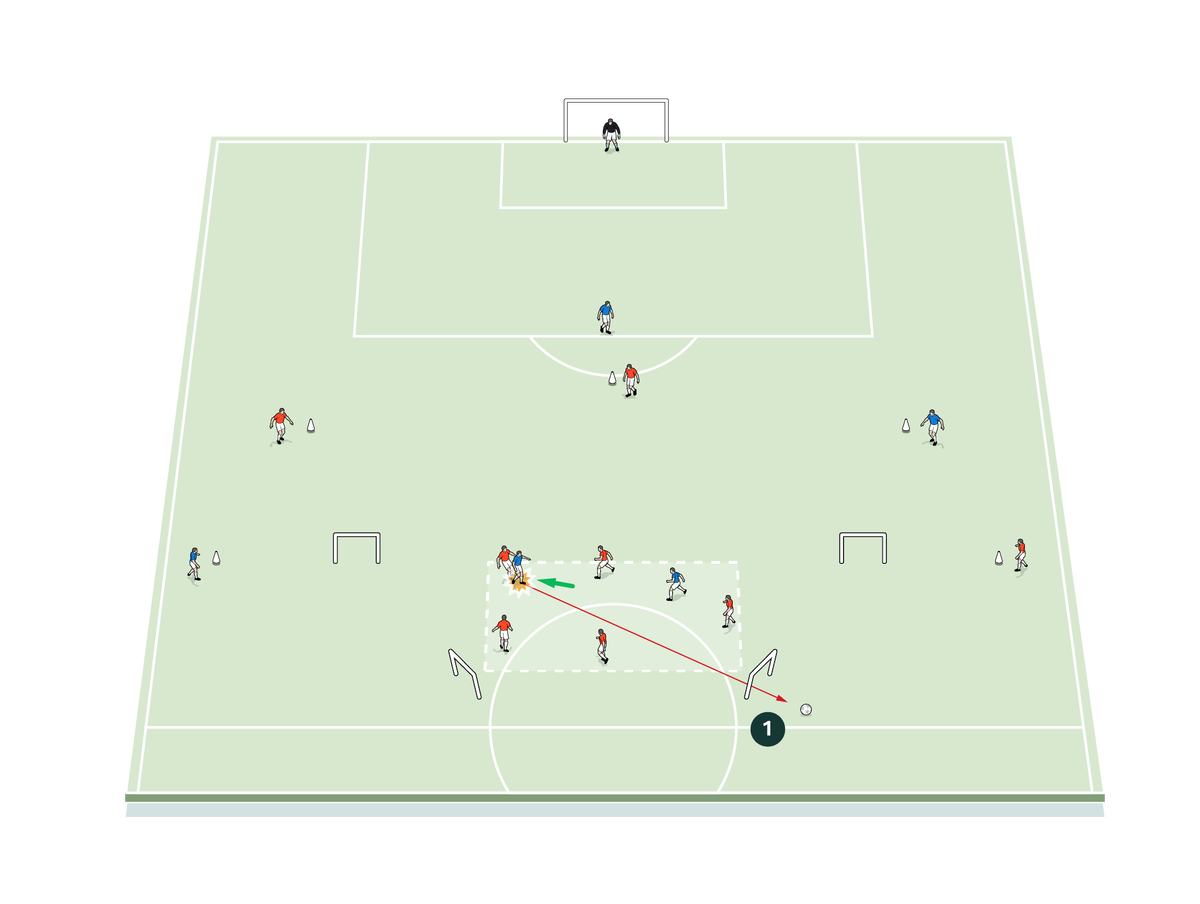
-
Two blues accelerate into rondo box, if they win ball and score in mini goals, it is worth two
The second part of the activity is also just the same, but now we also add mini goals outside the rondo box, so that if the blues win the ball back after the reds break [2b]...
[2b]
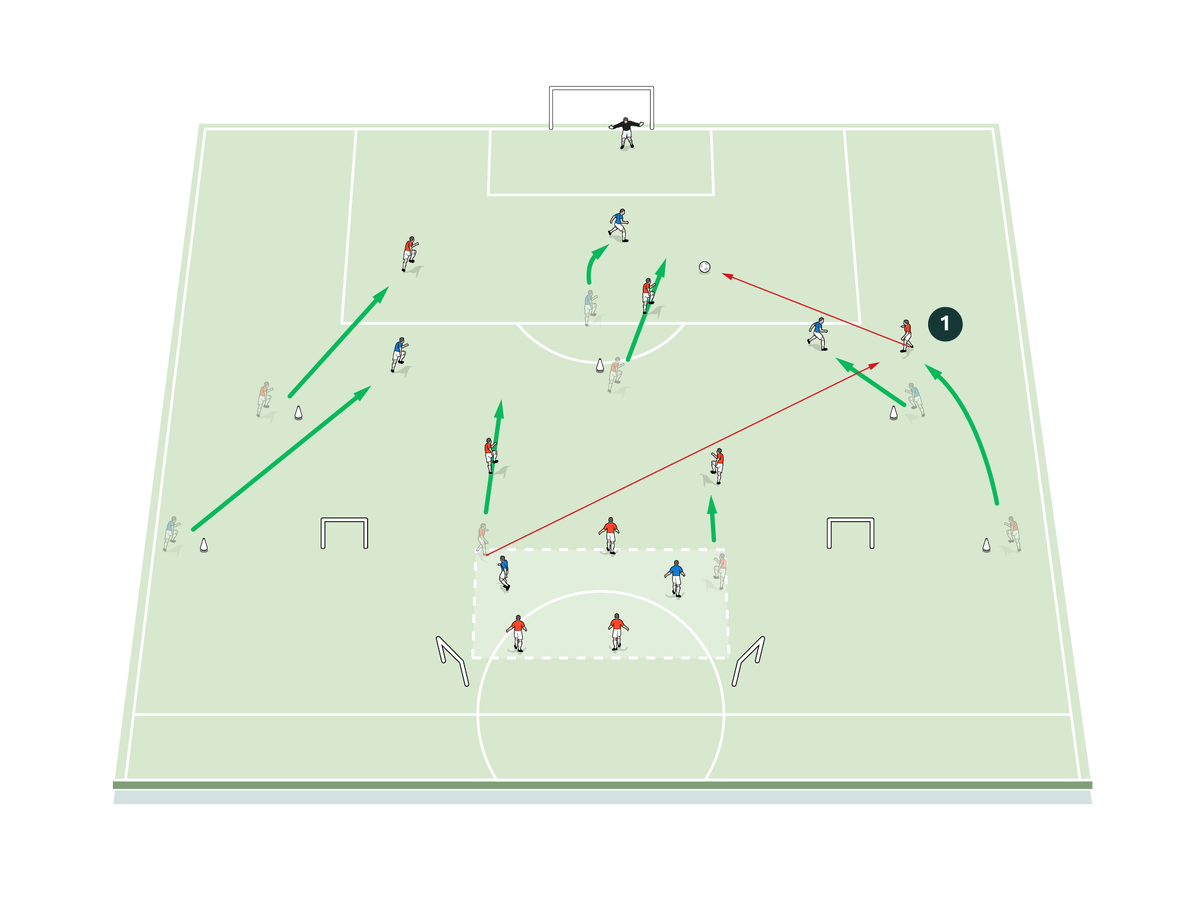
-
Reds break as before
...they can play out and counter, scoring into those mini goals [2c].
Rotate the sequence after between two and four reps, and move players into different spots in order to enhance the recovery.
You can adapt this drill by changing the initial pass to the transition to goal, for example rather than the ball into the forward, it can be played into the half space or deep into the channel.
[2c]
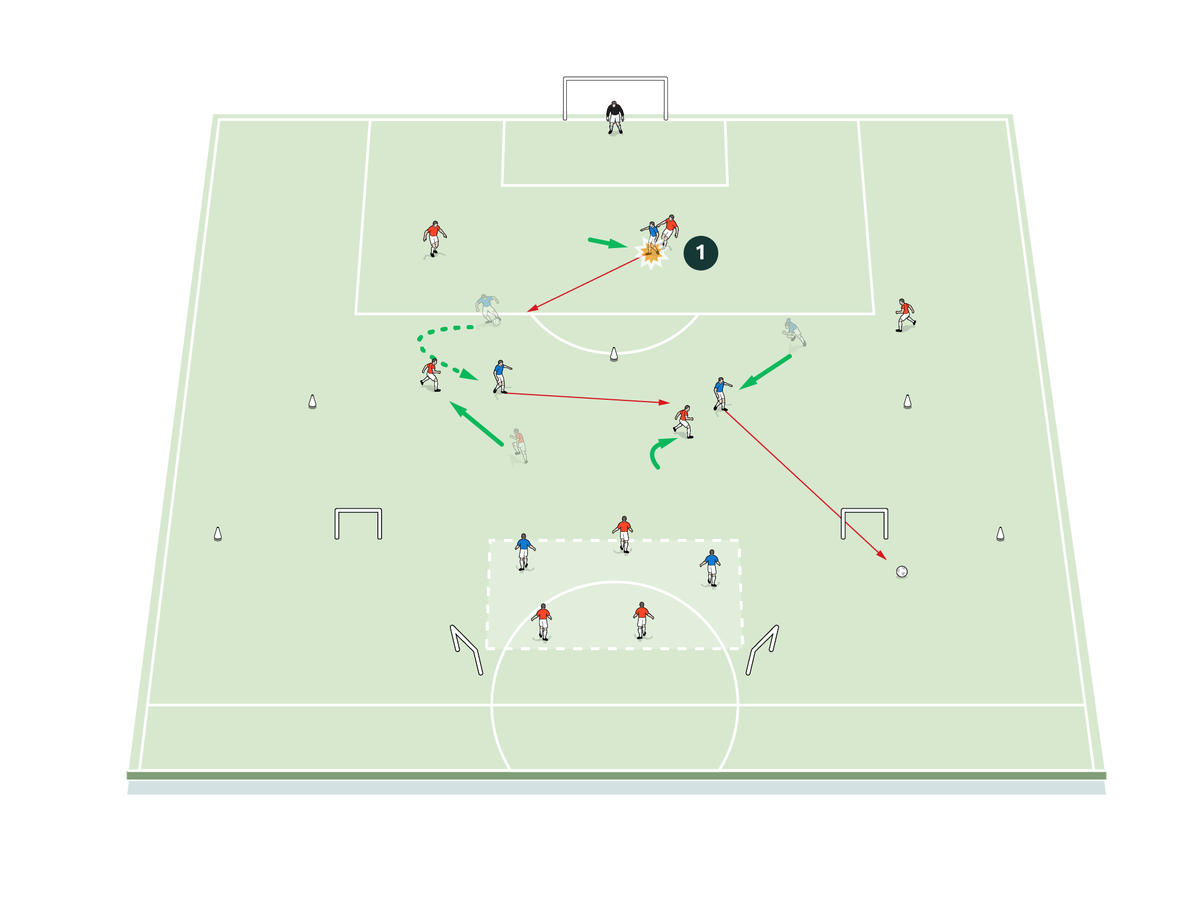
-
If blues win the ball back after the reds break, they can play out and counter, scoring into new mini goals
PROGRESSION
You can also progress into a transition small-sided game, 3v2, where the 3 attack the 2 at speed, and once a shot is taken, an extra player comes to join the two who are now attacking, and the player who shot steps out to ensure the transition continues.
We keep the pitch long and narrow, where we aim not to possess but to finish attacks quickly [3].
Here we see the reds begin by playing the ball diagonally to the other red. Three reds now enter to create a 3v2 game, against the two blues who have begun in the grid. The aim is to score as quickly as possible. The other players wait by the markers until they come into the game; once a red player shoots, that player steps out and the two remaining reds transition to defend against three new blues coming into the grid, completing the same sequence, beginning with the diagonal pass.
[3]

-
Reds begin by playing the ball diagonally to other red
-
Three reds now enter space to create a 3v2 game, against two blues who have begun in grid, with aim to score as quickly as possible
-
Once red player shoots, that player steps out and two remaining reds transition to defend against three new blues coming into grid
What are the key things to look out for?
Maximal speed is vital not only from a physical perspective but ensuring the attacking players maintain the time edge on the opposition. Breaking lines with the ball at the players’ feet or playing into the depth would be key principles to address.
Likewise, for the defensive group, recovery and containment would be key principles, clogging the middle and protecting the depth.
What are the typical mistakes players might make and how do I avoid them?
Typical mistakes might be transition turning into a possession, and players keeping the ball and circling back rather than maintaining the time edge.
Related Files
Editor's Picks
Deep runs in the final third
Using the goalkeeper in build-up play
Pressing principles
Intensive boxes drill with goals
Penetrating the final third
Creating and finishing
My philosophy
Pressing initiation
Compact team movement
Coaches' Testimonials

Alan Pardew

Arsène Wenger

Brendan Rodgers

Carlos Carvalhal

José Mourinho

Jürgen Klopp

Pep Guardiola

Roy Hodgson

Sir Alex Ferguson

Steven Gerrard
Coaches' Testimonials

Gerald Kearney, Downtown Las Vegas Soccer Club

Paul Butler, Florida, USA

Rick Shields, Springboro, USA

Tony Green, Pierrefonds Titans, Quebec, Canada
Join the world's leading coaches and managers and discover for yourself one of the best kept secrets in coaching. No other training tool on the planet is written or read by the calibre of names you’ll find in Elite Soccer.
In a recent survey 92% of subscribers said Elite Soccer makes them more confident, 89% said it makes them a more effective coach and 91% said it makes them more inspired.
Get Monthly Inspiration
All the latest techniques and approaches
Since 2010 Elite Soccer has given subscribers exclusive insight into the training ground practices of the world’s best coaches. Published in partnership with the League Managers Association we have unparalleled access to the leading lights in the English leagues, as well as a host of international managers.
Elite Soccer exclusively features sessions written by the coaches themselves. There are no observed sessions and no sessions “in the style of”, just first-hand advice delivered direct to you from the coach.






